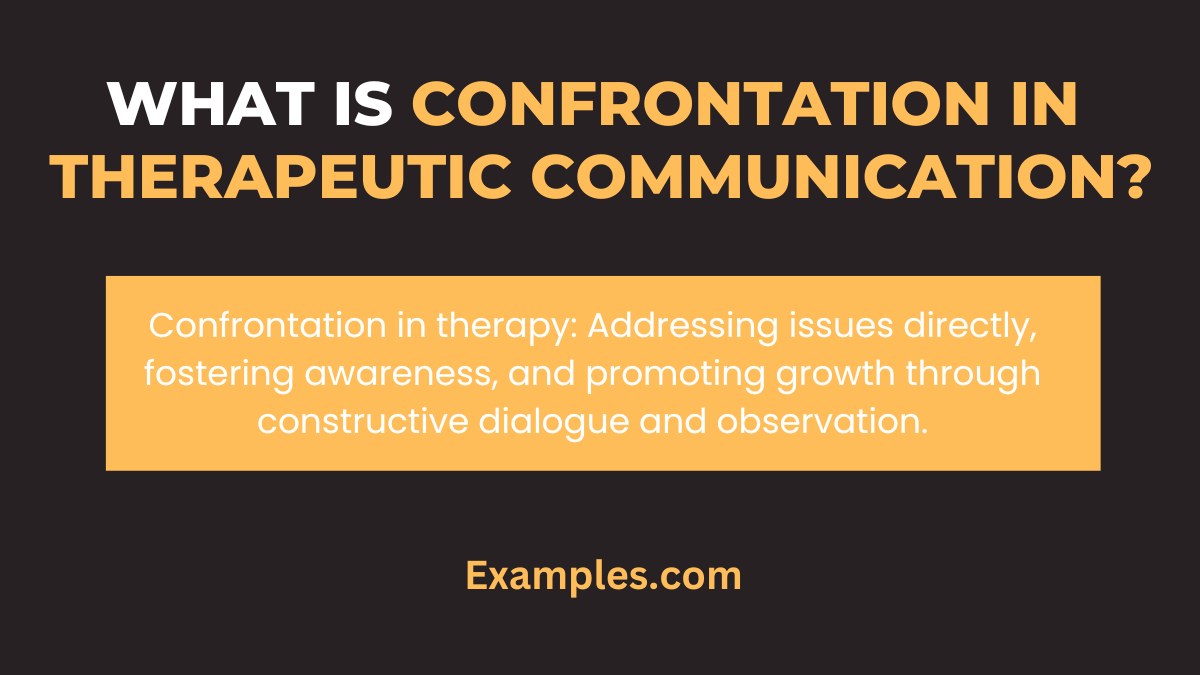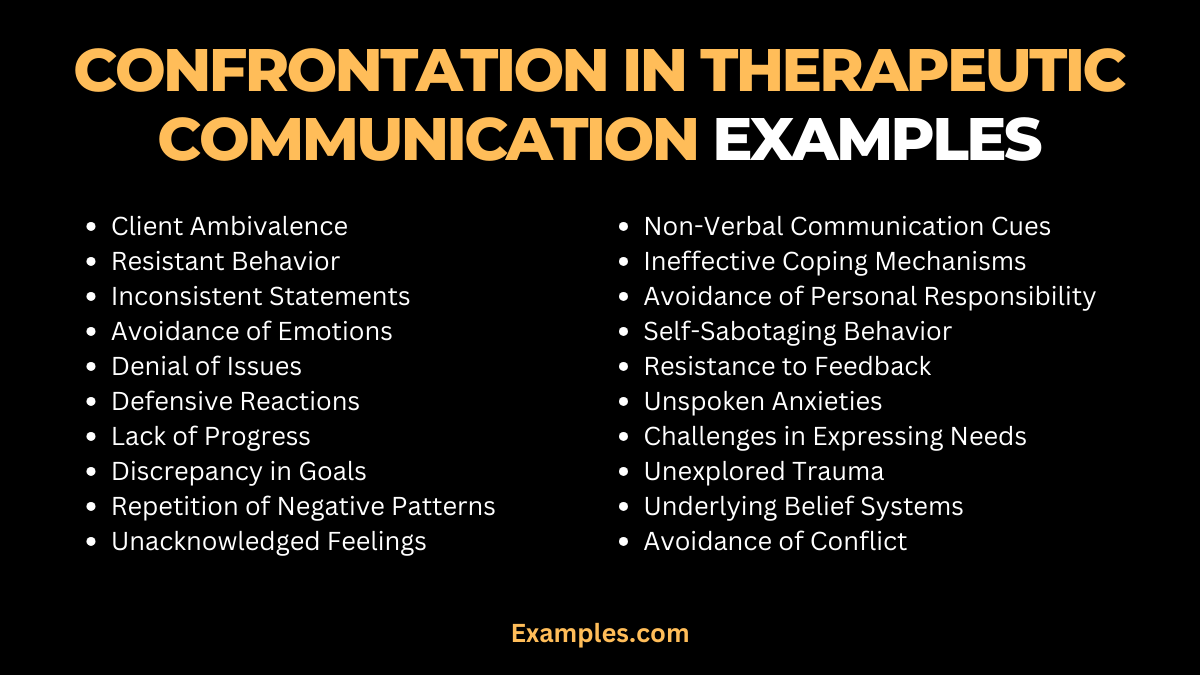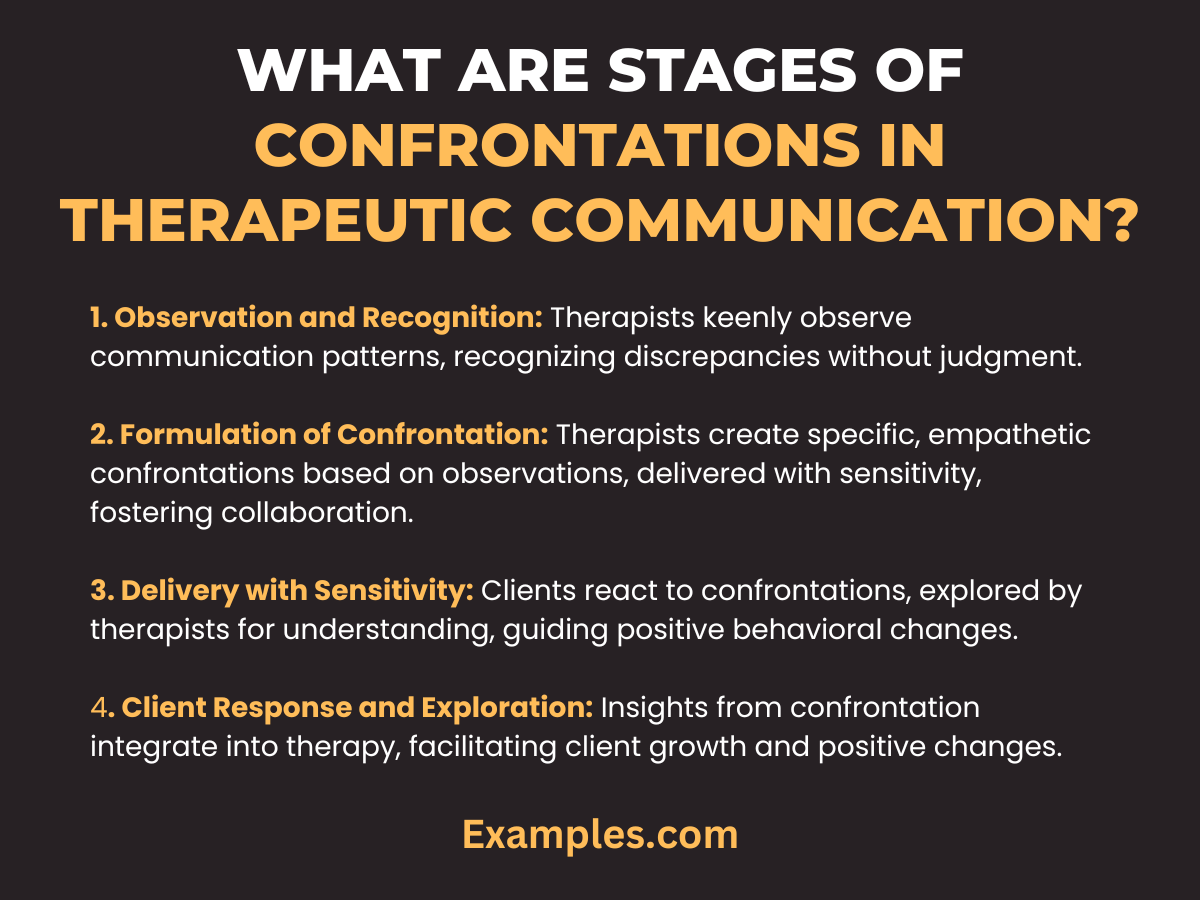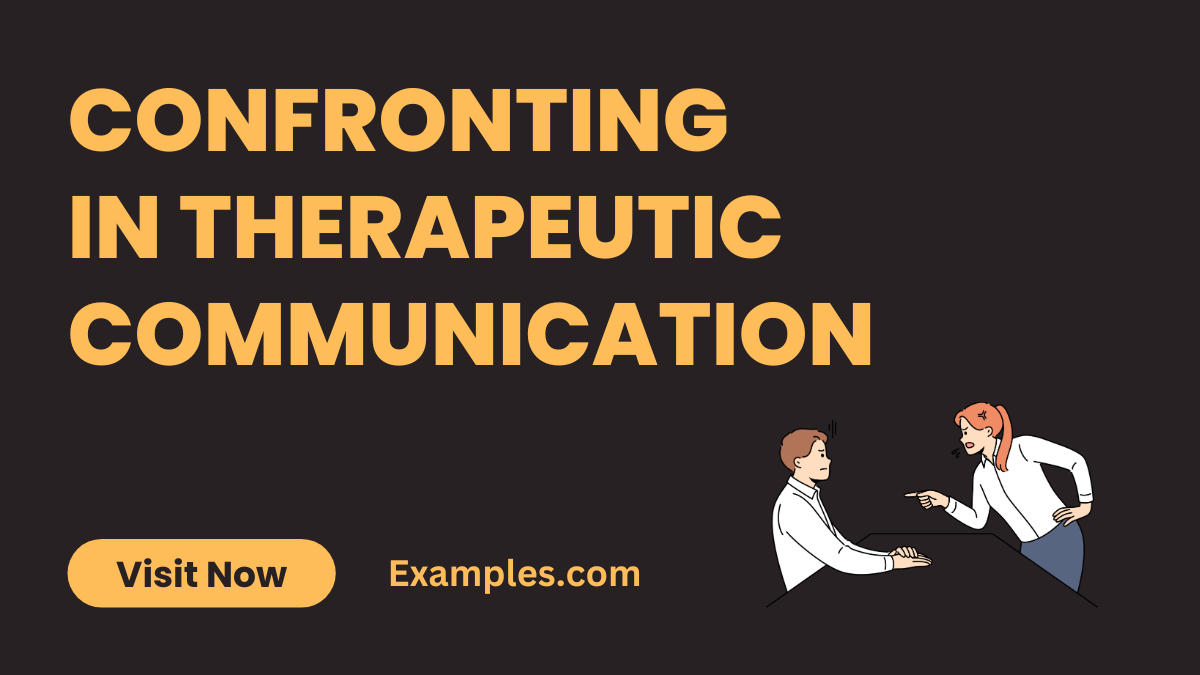19+ Confrontation in Therapeutic Communication Examples
Navigate the intricate terrain of therapeutic communication with our comprehensive guide on confrontation. Discover effective techniques, real-world examples, and expert tips to master the art of using confrontation as a therapeutic tool. Enhance your communication skills and foster positive change in therapeutic relationships through practical insights and illustrative communication examples.
What is Confrontation in Therapeutic Communication?

In therapeutic communication, confrontation is a deliberate and empathetic technique used to address discrepancies or inconsistencies in a client’s thoughts, behaviors, or feelings. It involves gently bringing these discrepancies to the forefront, fostering self-awareness, and promoting positive change in the therapeutic relationship. The goal is to explore, without judgment, areas of potential growth or internal conflict, facilitating a deeper understanding and progress in the therapeutic process.
20 Confrontation in Therapeutic Communication Examples

Unlock the power of confrontation in therapy with these impactful examples. Each scenario illustrates the delicate balance between empathy and insight, offering a nuanced approach to fostering growth and self-awareness.
- Client Ambivalence: Confront gently, “I sense you’re torn between choices. Let’s explore to clarify your feelings.”
- Resistant Behavior: Address tactfully, “I’ve noticed avoidance. What thoughts or fears might be behind this behavior?”
- Inconsistent Statements: Confront kindly, “You mentioned X earlier, but now it seems Y. Help me understand the shift.”
- Avoidance of Emotions: Approach with care, “I sense you’re avoiding discussing emotions. Can we explore that together?”
- Denial of Issues: Gently confront, “It appears there’s reluctance to acknowledge certain issues. What’s challenging about them?”
- Defensive Reactions: Confront empathetically, “I’ve observed defensiveness. Can we explore what might be triggering that response?”
- Lack of Progress: Address with support, “I notice a stall in progress. Let’s identify any barriers and work through them.”
- Discrepancy in Goals: Confront respectfully, “Your goals seemed aligned before; now, they seem different. Let’s revisit and clarify.”
- Repetition of Negative Patterns: Tactfully confront, “I see a recurring pattern. How might we shift towards a more positive approach?”
- Unacknowledged Feelings: Approach gently, “I sense certain emotions aren’t being fully acknowledged. Can we explore why?”
- Non-Verbal Communication Cues: Confront with observation, “Your body language signals discomfort. What’s beneath the surface?”
- Ineffective Coping Mechanisms: Address compassionately, “I’ve noticed certain coping mechanisms. Let’s explore healthier alternatives.”
- Avoidance of Personal Responsibility: Confront with care, “There’s a pattern of avoiding responsibility. Let’s discuss your role in these situations.”
- Self-Sabotaging Behavior: Tactfully confront, “Your actions seem counterproductive. Can we explore underlying motivations?”
- Resistance to Feedback: Approach with empathy, “I’ve observed resistance to feedback. Let’s understand your perspective.”
- Unspoken Anxieties: Confront gently, “I sense unspoken anxieties. Can we bring them into our conversation for exploration?”
- Challenges in Expressing Needs: Address with support, “It seems challenging to express needs. Let’s work on effective communication strategies.”
- Unexplored Trauma: Confront sensitively, “I sense there may be unexplored trauma. Would you like to share more about your experiences?”
- Underlying Belief Systems: Tactfully confront, “Certain beliefs may be influencing your decisions. Let’s examine them together.”
- Avoidance of Conflict: Approach with understanding, “I notice a tendency to avoid conflict. How can we navigate disagreements constructively?”
Confrontation in Therapeutic Communication Examples For Nursing Students
Empower nursing students with nuanced confrontation techniques. These examples cater to the unique challenges within healthcare settings, fostering skills essential for effective therapeutic communication.
- Boldly Addressing Work Ethic: “I’ve noticed inconsistencies in your clinical documentation. Let’s discuss strategies for improvement.”
- Encouraging Self-Reflection: “Your interactions with patients reflect certain hesitations. Can we explore your comfort levels in patient engagement?”
- Navigating Team Dynamics: “In team scenarios, I’ve observed a lack of assertiveness. How can we work on expressing your ideas more confidently?”
- Handling Stressful Scenarios: “During emergencies, your communication seems strained. Let’s strategize on maintaining clarity and composure.”
- Addressing Ethical Dilemmas: “Your response to an ethical concern raised questions. Let’s delve into the ethical frameworks guiding your decision-making.”
Confrontation in Therapeutic Communication Examples For Bipolar Disorder
Tailor confrontation for individuals with bipolar disorder, ensuring a supportive and understanding approach. These examples promote effective communication in the context of mental health challenges.
- Navigating Mood Swings: “I’ve observed fluctuations in your mood. Let’s explore triggers and coping mechanisms to manage these changes.”
- Addressing Medication Adherence: “There are concerns about inconsistent medication adherence. Can we discuss any barriers or concerns you might have?”
- Handling Impulsivity: “In impulsive moments, your communication may be impacted. How can we develop strategies for more deliberate responses?”
- Exploring Sleep Patterns: “Changes in your sleep routine may affect your well-being. Let’s examine patterns and consider adjustments for better stability.”
- Confronting Social Withdrawal: “I’ve noticed moments of social withdrawal. Let’s explore if there are specific triggers or if it’s related to your mood state.”
Is Confrontation a Therapeutic Communication Technique?
Confrontation, within the realm of therapeutic communication, serves as a strategic and constructive technique. It involves addressing discrepancies or inconsistencies in a client’s thoughts, behaviors, or emotions. Contrary to its negative connotation, therapeutic confrontation aims to enhance self-awareness, promote insight, and foster positive changes. This technique, when applied skillfully, becomes a valuable tool for therapists seeking to guide clients toward personal growth and improved mental well-being.
What are the Stages of Confrontation in Therapeutic Communication?

Confrontation unfolds through distinct stages, each contributing to the therapeutic process:
- Observation and Recognition:
- Therapists keenly observe inconsistencies or patterns in a client’s communication.
- Recognition involves acknowledging the observed discrepancies without judgment.
- Formulation of Confrontation:
- Based on observations, therapists formulate confrontations that are specific, empathetic, and focused on promoting understanding.
- Delivery with Sensitivity:
- The confrontation is presented to the client with sensitivity and empathy, emphasizing collaboration rather than criticism.
- Client Response and Exploration:
- Clients react to the confrontation, and therapists explore these reactions to deepen understanding and facilitate discussion.
- Integration and Application:
- The insights gained through confrontation are integrated into the therapeutic process, guiding clients toward positive behavioral changes.
What is the Impact of Confrontation in Therapeutic Communication?
The impact of confrontation is multi-faceted and contributes significantly to therapeutic outcomes:
- Enhanced Self-Awareness:
- Confrontations prompt clients to reflect on their thoughts and behaviors, leading to increased self-awareness.
- Insight Development:
- Clients gain insights into the root causes of challenges, fostering a deeper understanding of their emotional landscape.
- Behavioral Change Facilitation:
- Constructive confrontations empower clients to initiate positive behavioral changes, aligning with their therapeutic goals.
- Strengthened Therapeutic Alliance:
- Skillful use of confrontation strengthens the therapeutic alliance, as clients recognize the therapist’s commitment to their growth.
- Improved Communication Skills:
- Clients learn to express themselves more openly and authentically, contributing to improved overall communication skills.
- Empowerment and Self-Efficacy:
- Confrontations, when handled with care, empower clients by emphasizing their agency in making positive changes, fostering self-efficacy.
In conclusion, mastering confrontation in therapeutic communication is an art that empowers clients to navigate personal challenges and foster growth. Through empathetic observation, formulation, and delivery, therapists guide individuals towards profound insights, behavioral changes, and strengthened self-awareness. This comprehensive guide equips both therapists and clients with a transformative tool for fostering positive change in the therapeutic journey.



